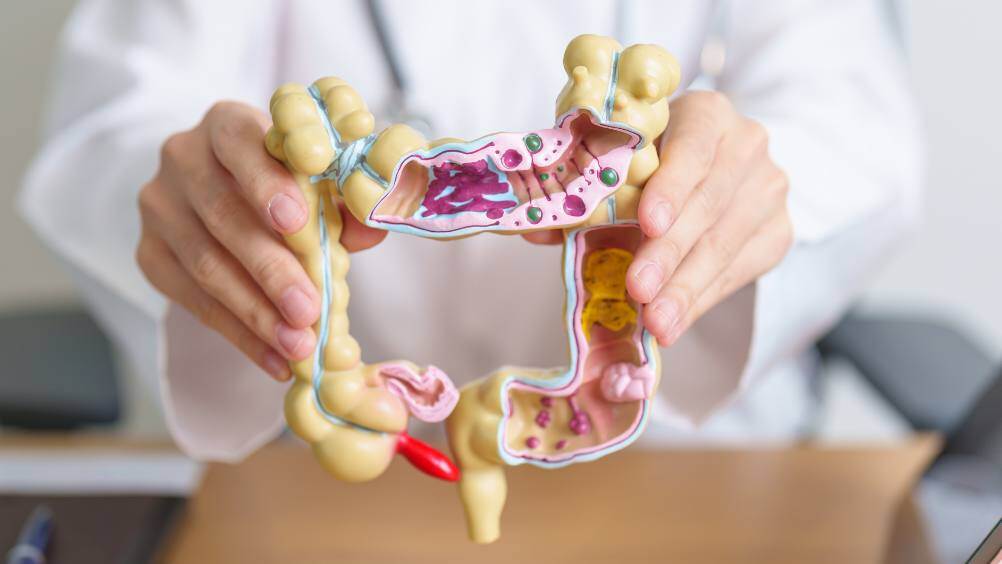A colon polyp is a small cluster of cells that develops on the colon's lining. Although most colon polyps are noncancerous (benign), they should not be overlooked. Some have the potential to develop into colon cancer over time. It's important to have a good understanding of colon polyps to prepare you for what to expect if any are found during a screening colonoscopy.
Reasons Colon Polyps Develop
Healthy colon cells go through their life cycle as expected, but changes in DNA can cause them to divide more often than they should, leading to overgrowth that develops into polyps.
Most experts believe your risk of developing polyps is linked to environmental factors and family history. Since genetics cannot be controlled, healthier lifestyle choices can help reduce the likelihood of developing polyps.
Risk Factors Linked to Colon Polyp Growth
It’s important to remember that your risk of developing polyps increases your risk of developing colon cancer slightly. However, most polyps, when found, are not cancerous. They can be removed before becoming precancerous or cancerous.
The following risk factors increase the likelihood of developing polyps.
- Age: Adults over the age of 45 are at an increased risk. On average, half of all adults have polyps.
- Race: Black people are more likely to develop colon cancer compared to white people.
- Family history: The risk goes up if you have relatives diagnosed with colon cancer or polyps (even non-cancerous polyps).
- Genetic abnormalities: Lynch syndrome, serrated polyposis syndrome, familial adenomatous polyposis, and other genetic changes can cause polyps to form.
- Inflammatory intestinal conditions: Ulcerative colitis and Crohn's disease are connected to a higher risk of polyps.
- Poor lifestyle choices: Being obese, eating an unhealthy, high-fat diet or a diet high in red meat, not exercising regularly, tobacco use, and excessive alcohol consumption increase the likelihood of developing polyps. This ultimately increases your risk of getting colon cancer.
What Are the Different Types of Colon Polyps?
There are five common types of colon polyps. These polyps are identified during a colonoscopy and removed when possible. A pathologist will examine the cells under a microscope after the colonoscopy to confirm the type of polyp that was removed and whether it showed signs of cancer.
The five categories are:
- Adenomatous polyps - the most common type, accounting for about 70% of all colon polyps, can become cancerous over time.
- Villous adenoma polyp - This type of flat-shaped polyp accounts for about 15% of polyps found during a colonoscopy. They are more difficult to remove and are more likely to be cancerous when found compared to adenomatous polyps.
- Sessile Serrated polyp - This type of polyp is rarely cancerous when located in the lower colon. However, larger-sized serrated polyps in the upper colon tend to be harder to detect and are typically precancerous.
- Hyperplastic polyps - They typically remain small and are usually benign, although they grow quickly.
- Inflammatory polyps - These are not technically polyps but inflammation caused by inflammatory bowel disease (IBD). Usually, only people with IBD are affected by inflammatory polyps, and they are unlikely to become cancerous.
How Colon Polyps Are Detected
Most polyps are detected during a routine colonoscopy performed by a gastroenterologist. A flexible tube with a camera is inserted into the rectum and then into the colon so the doctor can see inside your colon. Patients receive medication to help relax during the procedure, allowing the doctor to examine the colon for polyps. Any suspicious polyps found are removed and sent to a lab for testing.
It’s a good idea to start scheduling routine screening colonoscopies at the age of 45. If you have a family history or other risk factors for developing colorectal cancer, consult with your doctor, as you may need earlier screening for polyps.
Related Read: Colorectal Cancer Risk Factors: What Are They and Who Is at Risk?
Early detection of colon cancer is the key to a better chance of cure and complete recovery. In fact, some very small cancerous polyps can be removed during a colonoscopy with no further treatment needed. Follow-up colonoscopies and other tests will be recommended for these patients.
Are At-Home Stool Tests a Reliable Way to Find Polyps?
Many people like at-home stool tests like Cologuard® because they are private and easy to do. With this test, you send a small sample of your stool to a lab, where they check for blood and look for signs of cancer in your DNA. However, these tests cannot confirm if a polyp is the cause of blood in the stool, which means you'll still need to see a doctor for a colonoscopy to determine the exact cause.
Read our blog: What You Need to Know About At-Home Colorectal Cancer Screening
Does Having a Polyp Mean I Have Cancer?
It's important to understand that while most polyps are harmless, the bigger they are, the more likely they are to be cancerous. A study published by the American Journal of Gastroenterology in 2018 found that only 3.4% of polyps between 1 and 9 millimeters were cancerous, but for polyps 10mm or larger, the cancer rate jumped to 13.4%. This is why, starting at age 45, it's crucial to get a colonoscopy to detect and remove these polyps before they can develop into cancer.
Polyps Don’t Always Cause Symptoms
Most people with polyps don't have any symptoms, so it's important to get regular screenings. However, if polyps get big, they might cause these symptoms:
- Rectal bleeding
- Losing weight without trying
- Blood or mucus in your stool
- Unusual bowel habits, such as being constipated or having diarrhea for more than a week
- Stool that looks red or black in color
- Pain or stomach cramps from big polyps blocking the bowel
- Feeling tired and out of breath due to chronic bleeding from the polyps (anemia)
Treatment Options for Colon Polyps
Polyps can be removed painlessly during a colonoscopy using a polypectomy procedure. The two main methods for removing polyps are cutting them off with a wire loop or burning them off using an electrocautery device.
Depending on the type of polyp, follow-up care may be needed:
- Small hyperplastic polyps in the lower colon usually don't require follow-up for 10 years.
- Hyperplastic polyps in the upper colon may need more frequent follow-up colonoscopies.
- Adenomatous polyps will require a repeat colonoscopy based on their size, number, and appearance.
- Individuals who have a personal or family history of polyps are at an increased risk of developing new ones. People who have had adenoma have a 30% to 40% risk of recurrence within three years.
If the polyps found during a colonoscopy are large or pose a risk, a separate, minimally invasive surgical procedure might be necessary.
My Biopsy Confirmed a Cancerous Polyp: What Next?
Early detection of colorectal cancer through a screening colonoscopy greatly increases the chances of successful treatment. Willamette Valley Cancer Institute offers advanced colorectal cancer treatments and personalized treatment plans. If you had a biopsy and were diagnosed with colorectal cancer or need a second opinion, make an appointment with one of our specialists. Our offices are conveniently located in Albany, Corvallis, Eugene, Florence, Lincoln City, or Newport, Oregon.


